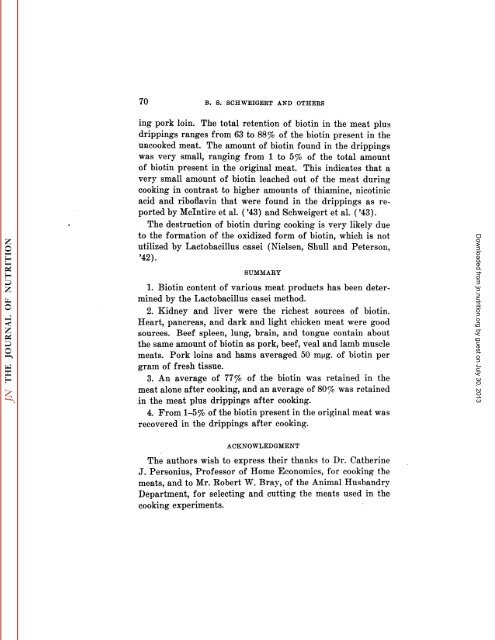BIOTIN CONTENT OF MEAT AND MEAT PRODUCTS 1 The biotin ...
BIOTIN CONTENT OF MEAT AND MEAT PRODUCTS 1 The biotin ...
BIOTIN CONTENT OF MEAT AND MEAT PRODUCTS 1 The biotin ...
Create successful ePaper yourself
Turn your PDF publications into a flip-book with our unique Google optimized e-Paper software.
70 B. S. SCHWEIGER! <strong>AND</strong> OTHERS<br />
ing pork loin. <strong>The</strong> total retention of <strong>biotin</strong> in the meat plus<br />
drippings ranges from 63 to 88% of the <strong>biotin</strong> present in the<br />
uncooked meat. <strong>The</strong> amount of <strong>biotin</strong> found in the drippings<br />
was very small, ranging from 1 to 5% of the total amount<br />
of <strong>biotin</strong> present in the original meat. This indicates that a<br />
very small amount of <strong>biotin</strong> leached out of the meat during<br />
cooking in contrast to higher amounts of thiamine, nicotinic<br />
acid and riboflavin that were found in the drippings as re<br />
ported by Mclntire et al. ( '43) and Schweigert et al. ( '43).<br />
<strong>The</strong> destruction of <strong>biotin</strong> during cooking is very likely due<br />
to the formation of the oxidized form of <strong>biotin</strong>, which is not<br />
utilized by Lactobacillus casei (Nielsen, Shull and Peterson,<br />
'42).<br />
SUMMARY<br />
1. Biotin content of various meat products has been deter<br />
mined by the Lactobacillus casei method.<br />
2. Kidney and liver were the richest sources of <strong>biotin</strong>.<br />
Heart, pancreas, and dark and light chicken meat were good<br />
sources. Beef spleen, lung, brain, and tongue contain about<br />
the same amount of <strong>biotin</strong> as pork, beef, veal and lamb muscle<br />
meats. Pork loins and hams averaged 50 mug. of <strong>biotin</strong> per<br />
gram of fresh tissue.<br />
3. An average of 11% of the <strong>biotin</strong> was retained in the<br />
meat alone after cooking, and an average of 80% was retained<br />
in the meat plus drippings after cooking.<br />
4. From 1-5% of the <strong>biotin</strong> present in the original meat was<br />
recovered in the drippings after cooking.<br />
ACKNOWLEDGMENT<br />
<strong>The</strong> authors wish to express their thanks to Dr. Catherine<br />
J. Personius, Professor of Home Economics, for cooking the<br />
meats, and to Mr. Robert W. Bray, of the Animal Husbandry<br />
Department, for selecting and cutting the meats used in the<br />
cooking experiments.<br />
Downloaded from<br />
jn.nutrition.org<br />
by guest on July 30, 2013
















